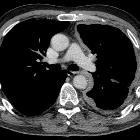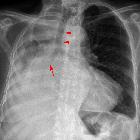Mesotheliom




































Mesothelioma, also known as malignant mesothelioma, is an aggressive malignant tumor of the mesothelium. Most tumors arise from the pleura, and so this article will focus on pleural mesothelioma.
Given the presence of the mesothelium in different parts of the body, mesothelioma can arise in various locations :
- pleural mesothelioma (~90%) - covered in this article
- peritoneal mesothelioma (~10%)
- pericardial mesothelioma (<1%)
- cystic/multicystic mesothelioma
- tunica vaginalis testis mesothelioma (<1%)
Epidemiology
Mesothelioma is an uncommon entity and accounts for 5-28% of all malignancies that involve the pleura . There is a strong association with exposure to asbestos fibers (~10% risk during lifetime; 40-80% of patients have a history of asbestos exposure) with risk associated with duration and breadth of exposure . Para-occupational exposure (e.g. household members of asbestos-exposed workers) can also occur .
Not all types of asbestos are strongly implicated, with crocidolite being the main causative fiber type. Not surprisingly, given the sources of asbestos exposure being predominantly mining, construction, lagging and machinery mechanics, 60-80% of cases are encountered in males, in general, 20 to 35 years after exposure . Some areas of the world have very regional hotspots, such as Belfast in Northern Ireland, due to the historic shipbuilding industry.
There is also increased risk for those with household exposure (e.g. family of exposed workers) .
There has been no convincing evidence for an association with smoking .
Clinical presentation
Typically patients present with dyspnea and low back non-pleuritic chest pain. Pleural effusions are seen in the vast majority of patients at some stage during their disease . Up to 25% of patients have metastatic disease at the time of presentation if staged with FDG PET .
Typically mesothelioma is thought of as a locally-aggressive disease, however distant extranodal metastases are seen , albeit uncommonly. In a postmortem study of 318 patients, 55% patients were found to have extrathoracic metastases, the commonest sites being the liver (32%), spleen (11%), thyroid (7%) and brain (3%) . Of course the prevalence of metastases on imaging is likely to be lower than on postmortem studies.
Pathology
Etiology
- asbestos-fiber exposure: causes the majority of cases
- erionite-fiber exposure: naturally occurring mineral used in building, particularly in Turkey
- simian virus 40 (SV40)
- radiation exposure
Histology
There are three histological types of mesothelioma:
The cytological and histological diagnosis can be difficult, with mesothelial hyperplasia and metastatic adenocarcinoma appearing similar. Specific markers are helpful including:
- calretinin
- epithelial membrane antigen
- cytokeratin
- mesothelin (elevated in 84% of malignant mesothelioma versus <2% with other pleural diseases )
Subtypes such as multicystic/cystic mesothelioma are rarer and less aggressive.
Radiographic features
See: staging of malignant pleural mesothelioma.
Plain radiograph
Chest radiographs are non-specific and of limited utility . The following features may be evident:
- pleural opacity which may extend around and encase the lung
- reduced volume of the affected hemithorax, resulting in ipsilateral shift of the mediastinum (common)
- rib destruction or extension beyond the lateral and anterior margins of the chest wall
- +/- mediastinal lymphadenopathy
- +/- pleural effusion; most commonly is unilateral and exudative or hemorrhagic in nature, with frozen hemithorax (not causing mediastinal shift)
CT
CT is most commonly used for imaging assessment of mesothelioma, and sufficient for accurate staging of disease in most patients.
- pleural mass or nodular thickening of soft tissue attenuation
- tends to cause "inward" contraction of the hemithorax, e.g. ipsilateral mediastinal shift
- pattern of spread
- pattern of spread initially to adjacent pleura
- involvement pleural fissures
- eventually grows toward lung encasement ("pleural rind')
- predilection for local invasion
- involvement of chest wall, diaphragm, and mediastinal content typical
- chest wall involvement
- infiltration of the extra-pleural fat plane
- obvious direct extension in bone or muscle
- known to invade along prior catheter and biopsy tracks
- pericardial effusion may suggest transpericardial extension
- frequent metastasis to local lymph nodes and contralateral lung
- pattern of spread initially to adjacent pleura
- calcification
- seen in 20% - usually represents engulfment of calcified pleural plaques rather than true tumor calcification
- sarcomatoid variants may contain calcific osteosarcoma or chondrosarcomatous components
An uncommon variant is the solitary mediastinal malignant mesothelioma which has appearances reminiscent of a solitary fibrous tumor of the pleura .
MRI
MRI, although not routinely used, may have a role in refining the staging and better delineating the extent of the disease in surgical candidates especially concerning the chest wall and diaphragmatic invasion .
- T1: iso to slightly hyperintense c.f muscle
- T2: iso to hyperintense c.f muscle
- C+ (Gd): enhancement usually present
PET
Positron emission tomography is becoming useful in two clinical settings :
In addition, there appears to be a correlation between the degree of FDG uptake and the biological aggressiveness of the tumor, which may help to guide treatment .
Treatment and prognosis
Treatment continues to be challenging and the long-term survival is poor. Single modality treatment (surgery, radiotherapy, chemotherapy, immunotherapy and even photodynamic therapy) have not been shown to improve survival . More recently multi-modality treatment has had some impact on favorable subgroups (early disease, and epithelioid histology). Treatment includes:
The prognosis is poor for all tumor types with a median overall survival without treatment of 4-12 months . In favorable patient subgroups up to 45% 5-year survival may be achievable , however even with aggressive multi-modality therapy overall 5-year survival remains poor (3-18%) with a median survival time of approximately 18 months .
Differential diagnosis
The differential is dependent on the exact nature of tumor involvement and the modality. General imaging differential considerations include
- pleural effusion (especially if loculated): on radiographs
- pleural metastases (especially with pleural carcinomatosis)
- peripheral bronchogenic carcinoma
- solitary fibrous tumor of pleura
- other pleural based tumors
- tumor like conditions of the pleura
- benign asbestos-related pleural disease
- pleural fibrosis from infective/inflammatory source (e.g. actinomycetes, tuberculosis)
Practical points
- avoid the temptation of performing an image-guided biopsy, as mesothelioma is notorious for aggressively seeding along the biopsy track
Siehe auch:
- Pleuraerguss
- Lungenkarzinom
- Pleuraempyem
- Pleurakarzinose
- solitärer fibröser Tumor der Pleura
- Pleuramesotheliom
- peritoneales Mesotheliom
- malignant mesothelioma of the tunica vaginalis testis
und weiter:
- Pancoast tumour
- Pierre-Marie-Bamberger-Krankheit
- Empyema necessitans
- komplette Verschattung Hemithorax
- Pleuraplaques bei Asbestose
- psammoma bodies
- differential of a large unilateral pleural effusion
- fibrinous pericarditis
- Thorax Onlinekurs
- small round blue cell tumours
- Tafelberg Asbest
- Asbest assoziierte Erkrankungen
- primäres Mesotheliom des Perikards
- Pleuraverdickung
- cystic peritoneal mesothelioma
- multizystisches Mesotheliom

 Assoziationen und Differentialdiagnosen zu Mesotheliom:
Assoziationen und Differentialdiagnosen zu Mesotheliom:




